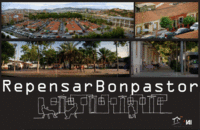Ideas behind “Bonpastor”: t@gether, on this occasion inh@bit@nts can win
The ideas competition "Repensar Bonpastor", sponsored by the IAI and organised by a group of architects, anthropologists and local planners, had a great success with over 150 teams enrolled. The Jury has selected four proposals as the best with the fifth one being awarded a special recognition. The winning teams consist of technicians from Spain, Holland, Great Britain, Germany, Italy, Greece and Colombia, who have contributed towards the study concerning participatory urban regeneration and zero evictions at Bon Pastor’s “casas baratas” (“affordable housing”) neighbourhood in Barcelona. It is about gathering ideas to enable all people to benefit from, which has the opposite effect towards the City Council’s demolitions which have already begun in the neighbourhood.
The proposals aim to find a solution for the district enabling all residents who wish to remain in their homes, to be given the rehabilitation they may require whilst seeking other ways to increase the density of habitable land within the area, without breaking the social fabric or loss of historical heritage.
The project “Ante la división, la participación ”, prepared by Naomi Ferguson and Afroditi Karagiorgi proposes the participatory approach of the European Awareness Scenario Workshops (EASW) to enable the development of an alternative solution towards the demolition problem in aid of “casas baratas” tenants, detailing the different stages to follow. The project “Bon Pastor, barrio de código abierto ”, organised by Marian Simon Nerea Morán, Cristina Fernandez, Gorka Ascasíbar and Quim Vilar, proposes to establish a people cooperative to manage the entire process, such as the new buildings’ construction as the recovery of permitted houses, the cooperative public spaces management and mobility. Such an approach would allow for strong sustainability, constantly fed back through practical experience. The project “Refining Bonpastor ”, instigated by Karin Fernanda Schwambach, Susan Field Eipper and Fernando Medina, provides a report initially to determine the needs of every household with the principal aim to arrive at pre-intervention project stage for the neighbourhood to submit for a final collective decision making. The project would consist in the extension of some houses, pedestrianising some streets, and construction of new residential buildings for those in need. Finally, the project “With-in walls ”, prepared by Barbara Dovarch, Stefano Grigoletto, Sara Incerti, Gynna Milan, Marta Pietroboni, Luca Serra and Pietro Pusceddu, reflects on the potential offered by "casas baratas" within their walls. Increasing the neighbourhood's residential density would have to accommodate both the residents’ needs and public demands without loosing sight of the neighbourhood’s qualitative and peculiar lifestyle aspects.
Based on Barcelona City Council’s decision in 2003 to proceed with the demolition of all 784 "casas baratas" – public housing units built in 1929 for single-families – the neighbourhood’s tenants have lived under a growing number of tensions and conflicts, often even within the same families. This situation reached its peak during October 2007 with a series of forced evictions of historical families from the neighbourhood, forced to leave the dwellings they were once born and accept the conditions imposed by the City Council, with several injuries inflicted upon them thanks to police intervention. The neighbourhood’s residents, since 2003 remain opposed towards this imposition, have since rallied the "Avis of Barri” association where they have called for the assistance of the International Alliance of Inhabitants to help find an alternative solution to the conflict. Therefore, the aim behind the ideas competition “Repensar Bonpastor” is to find ways to develop alternative solutions to the neighbourhood’s demolition problem balancing the needs of all housing tenants and recreate the unity among neighbours under the horizontally structured area that would permit this and brought the demolition project to a halt. Despite the different communities living in the neighbourhood, there is the possibility to unite them under a common cause. The division was created artificially by the City Council and legitimized the "participatory" project as clearly unpopular.
A shared solution that engages and does not bring harm to one section of the population for the benefit of another, and that "casas baratas" really arises from inhabitants, is a possibility under Bon Pastor. The 46 projects submitted, in particular those that the Jury selected and awarded represents a valid contribution towards the development and ownership of alternative proposals on the district’s part. For this purpose, it is essential to encourage dialogue among the conflicting parties, which currently seems suspended.
During May, the selected projects will be presented in the district and meanwhile, develop a shortlist publication of the most interesting proposals which will serve as material to be distributed to tenants concerning "casas baratas".
If the neighbourhood’s unity seems a nostalgic reminder of a past "pre-regeneration", many elements of the competition process make us think that today’s divisions can be overcome. To achieve a future in which the Bon Pastor’s residents are really genuine heroes and that this change is not destructive or generate more forced evictions.
– BON PASTOR HISTORY
The 784 "casas baratas" were built in 1929 by the City Council’s Municipal Housing. The neighbourhood back then was plain countryside and the Besos River often flooded homes. Bon Pastor, who at the time was referred to as "Milans del Bosch”, was mainly inhabited by Southern Spanish immigrants. During the Spanish Civil War, it was one of the most anti-fascists militants in Barcelona and it was severely punished for this reason: first by aerial bombardment and then for reprisals by the Franco regime, suffering decades-long of isolation and misery. Many people were exiled; others immersed in fear and hunger were abandoned by the institutions and resorted to self-deprivation. After the dictatorship, Bon Pastor saw its history of political and social demands replaced by another, more negative, identity: a degraded area, immersed in drug trade. In the eighties, when there was heroin frenzy among the "casas baratas" young people, the Patronato sponsored a housing restoration but with few resources. At the beginning of the speculative millennium frenzy, the district found itself within an area of influence attributed by the "Cultural Forum” and La Sagrera, the new High Speed Railway Train Station. The demolition project reared its ugly head once more during Franco’s dictatorship, but this time the Neighbourhood Association during which time have channelled through sufficient claims, voted in favour of the project. To oppose the demolition, the Barri Avis Association was established in 2003, accusing the City Council of false propaganda in promoting regeneration that not only implied a collective loss of historical memory and the traditional characteristic lifestyle of the neighbourhood, but it also represented a significant economic damage to the oldest industry and fewer housing tenants’ resources. In 2007, the first 145 "affordable homes" became demolished and in October there was a violent expulsion and a police charge against the inhabitants. The demolition of the following 192 houses is scheduled for late 2010 but the current economic downturn makes the future of both the neighbourhood and its people even more uncertain. Many housing residents are in serious financial difficulties and cannot afford to buy the flats that the Council have offered to compensate for the housing demolition.

